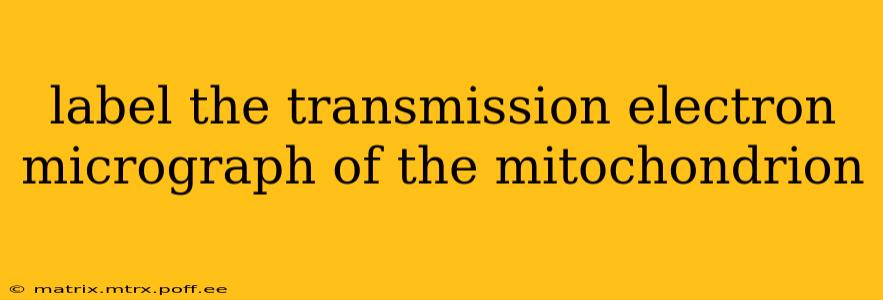Mitochondria, often called the "powerhouses" of the cell, are complex organelles with a distinctive double-membrane structure. Understanding their ultrastructure is crucial for comprehending their vital role in cellular respiration and energy production. This guide will walk you through labeling the key components visible in a transmission electron micrograph (TEM) of a mitochondrion.
A TEM provides a high-resolution image of the mitochondrion's internal structures. While the exact details visible depend on the preparation and magnification of the micrograph, key features consistently appear. Let's explore these features and how to identify them:
Key Structures to Label in a Mitochondria TEM
Here's a breakdown of the essential components you'll typically find in a mitochondrion TEM, along with their functions:
1. Outer Mitochondrial Membrane: This is the smooth, outer boundary of the mitochondrion. It's relatively permeable due to the presence of porins, which are protein channels allowing the passage of small molecules.
2. Inner Mitochondrial Membrane: This membrane is highly folded into cristae, significantly increasing its surface area. This increased surface area is critical for housing the electron transport chain and ATP synthase, key players in oxidative phosphorylation—the process that generates the majority of cellular ATP (adenosine triphosphate), the cell's primary energy currency.
3. Cristae: These are the characteristic inward folds of the inner mitochondrial membrane. Their intricate structure maximizes the space available for the enzymes involved in ATP synthesis. The number and shape of cristae can vary depending on the cell type and its metabolic activity.
4. Mitochondrial Matrix: This is the space enclosed within the inner mitochondrial membrane. It's filled with a dense, protein-rich solution containing mitochondrial DNA (mtDNA), ribosomes, and enzymes responsible for the citric acid cycle (also known as the Krebs cycle) – a crucial step in cellular respiration.
5. Intermembrane Space: This narrow region lies between the outer and inner mitochondrial membranes. It plays a role in the electrochemical gradient crucial for ATP synthesis. The proton concentration difference across the inner membrane drives ATP production.
Frequently Asked Questions (FAQs)
What are the functions of the different parts of the mitochondrion?
As detailed above, each part plays a vital role: the outer membrane acts as a barrier, the inner membrane houses the electron transport chain and ATP synthase, cristae increase surface area for ATP production, the matrix contains enzymes for the citric acid cycle and mitochondrial DNA, and the intermembrane space contributes to the proton gradient driving ATP synthesis.
How does the structure of the mitochondrion relate to its function?
The highly folded inner membrane (cristae) significantly increases the surface area available for ATP production. The compartmentalization into the matrix and intermembrane space allows for the creation of the proton gradient necessary for ATP synthesis via chemiosmosis. The presence of mtDNA and ribosomes within the matrix enables the mitochondrion to synthesize some of its own proteins.
What is the role of mitochondrial DNA (mtDNA)?
Mitochondrial DNA encodes for some proteins needed for oxidative phosphorylation. It's important to note that mtDNA is inherited maternally.
How can I tell the difference between the outer and inner mitochondrial membranes in a TEM?
The outer membrane is typically smoother than the highly folded inner membrane, which appears as numerous cristae projecting into the matrix.
What are the differences between mitochondria in different cell types?
The number and morphology of mitochondria (size and shape of cristae) vary significantly depending on the energy demands of the specific cell type. Highly active cells, like muscle cells, typically have many more mitochondria than less active cells.
By carefully examining the TEM and understanding the unique characteristics of each labeled structure, one can gain a deeper appreciation for the complex machinery of the mitochondrion and its vital contribution to cellular life. Remember to always consult reliable sources and refer to high-quality micrographs for accurate labeling.
